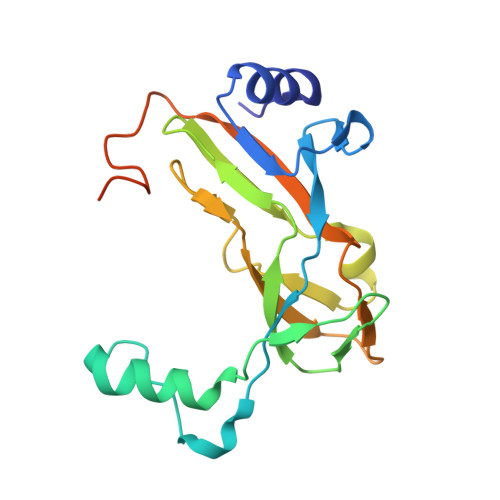Regulation of Dctp Deaminase from Escherichia Coli by Nonallosteric Dttp Binding to an Inactive Form of the Enzyme
Johansson, E., Thymark, M., Bynck, J.H., Fanoe, M., Larsen, S., Willemoes, M.(2007) FEBS J 274: 4188
- PubMed: 17651436
- DOI: https://doi.org/10.1111/j.1742-4658.2007.05945.x
- Primary Citation of Related Structures:
2J4H, 2J4Q - PubMed Abstract:
The trimeric dCTP deaminase produces dUTP that is hydrolysed to dUMP by the structurally closely related dUTPase. This pathway provides 70-80% of the total dUMP as a precursor for dTTP. Accordingly, dCTP deaminase is regulated by dTTP, which increases the substrate concentration for half-maximal activity and the cooperativity of dCTP saturation. Likewise, increasing concentrations of dCTP increase the cooperativity of dTTP inhibition. Previous structural studies showed that the complexes of inactive mutant protein, E138A, with dUTP or dCTP bound, and wild-type enzyme with dUTP bound were all highly similar and characterized by having an ordered C-terminal. When comparing with a new structure in which dTTP is bound to the active site of E138A, the region between Val120 and His125 was found to be in a new conformation. This and the previous conformation were mutually exclusive within the trimer. Also, the dCTP complex of the inactive H121A was found to have residues 120-125 in this new conformation, indicating that it renders the enzyme inactive. The C-terminal fold was found to be disordered for both new complexes. We suggest that the cooperative kinetics are imposed by a dTTP-dependent lag of product formation observed in presteady-state kinetics. This lag may be derived from a slow equilibration between an inactive and an active conformation of dCTP deaminase represented by the dTTP complex and the dUTP/dCTP complex, respectively. The dCTP deaminase then resembles a simple concerted system subjected to effector binding, but without the use of an allosteric site.
- Centre for Crystallographic Studies, Department of Chemistry, University of Copenhagen, Denmark. evjh@novonordisk.com
Organizational Affiliation:



















